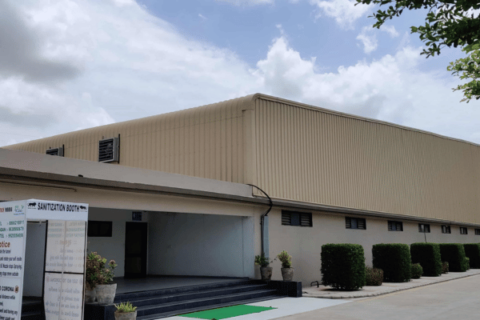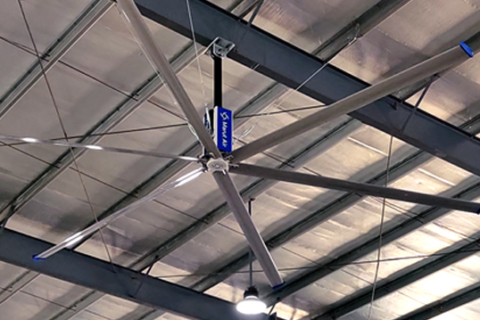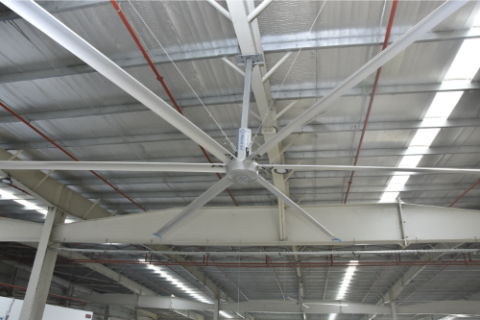Overheating is a common problem in industrial settings, which can negatively affect employee health and output. Using industrial fans, which offer a cheap and energy-efficient approach to cooling these areas, is one practical way to address this problem.
Temperature Control in Industrial Settings Is Essential
High temperatures can have a variety of negative consequences for employees, from weariness and discomfort to more serious health problems, including heat exhaustion and heat stroke. It’s critical to keep industrial environments comfortable to ensure worker productivity and well-being.
How do industrial fans work?
Industrial fans function by moving air across an area to help disperse heat and keep the temperature constant. Axial fans, centrifugal fans, Industrial Portable HVLS Fans, and HVLS fans (High Volume, Low Speed) are among the different kinds of industrial fans that are available; each has advantages and applications of its own.
Advantages of Industrial Fans
Better ventilation and air circulation:
Industrial fans aid in the uniform distribution of air, preventing pockets of stagnant air and guaranteeing a comfortable working environment for employees.
Economical cooling option:
Industrial fans are significantly less expensive to buy, install, and run than air conditioning.
Ecological and energy efficient:
Industrial fans use less energy than air conditioners, which lowers carbon emissions and overall energy use.
Considerations for Selecting Industrial Fans
The following criteria, arranged in a point-by-point manner, should be taken into account while selecting industrial fans:
Dimensions and Absorbency Requirements:
To calculate the size and quantity of fans required, take into account the dimensions and configuration of your workplace. To properly circulate air in larger rooms, more fans or larger fan sizes can be needed.
Noise levels:
In some environments, the noise that industrial fans make has the potential to be disruptive. If noise is an issue, look for fans with lower noise levels or take into account features that reduce noise
Energy Efficiency Ratings:
To cut operating expenses, select fans with excellent energy efficiency ratings. Seek for fans with energy-efficient motors and variable speed settings, among other features.
Long-Term Cost Savings:
Take into account the fan’s long-term cost savings, which include energy efficiency and maintenance expenses. An energy-efficient fan that costs a little extra up front might save more money over time.
Installation and Maintenance:
Take into account the fan’s simplicity of installation and maintenance needs. To reduce downtime and maintenance expenses, select a fan that is simple to install and maintain.
Integration with Current HVAC Systems:
Take into account how the industrial fan will work with any current HVAC systems, if you have any. To get the most out of your cooling system, pick a fan that can cooperate with it.
Also Read: Industrial HVLS Fans in Automotive Manufacturing: Improving Air Quality and Worker Comfort
Durability and Quality:
Seek for fans constructed of robust materials that are able to endure the demanding conditions seen in industrial settings. Select fans from respectable producers who are well-known for their dependability and quality.
Airflow and Cooling Effectiveness:
Take into account the fan’s ability to provide both. Select a fan that can adequately circulate air to cool your workstation.
Safety Features:
To avoid mishaps and injuries, look for fans with guards or other safety features. Think carefully about where to put the fan to make sure employees aren’t in danger.
Regulatory Compliance:
Verify that the fan conforms to all applicable safety and regulatory requirements specific to your sector and region.
When selecting industrial fans, take these variables into careful consideration to make sure the fan you choose is appropriate for your environment and demands.
The Best Ways to Use Industrial Fans
For the best cooling and airflow, industrial fans must be positioned correctly. In order to guarantee that fans run properly and efficiently, regular maintenance is also necessary. To improve cooling even more, industrial fans can be integrated with current HVAC systems.
Conclusion
During the summer, industrial fans are a great tool for keeping workplaces cool. They are a wise option for companies trying to establish a cozy and effective work atmosphere because of their capacity to increase energy efficiency, promote air circulation, and offer affordable cooling. To combat the summer heat, think about adding industrial fans to your cooling systems.





